Table of contents
India, with its rich cultural and religious heritage, is home to various temple architectural styles.
Each style reflects the diversity of the country's geography, culture, and historical periods.
Understanding these styles is crucial for UPSC aspirants as part of the Art and Culture syllabus.
Nagara Style (North Indian Temple Architecture)
- Geographical Spread: Predominantly in Northern India.
- Key Features:
- Shikhara: The tower or spire is curvilinear, and unlike the Dravidian style, it doesn't have a capstone.
- Garbhagriha: The sanctum sanctorum housing the deity is usually located beneath the tallest tower.
- Lack of Enclosures: Temples don't usually have large boundary walls or enclosures.
- Amalaka: A stone disk, resembling a lotus, is placed atop the shikhara.
- Mandapa: The assembly hall leading to the sanctum, often smaller than the main shrine.
- Key Features:
- Examples: The Sun Temple at Konark, the Khajuraho group of temples, the Lingaraj Temple at Bhubaneswar.
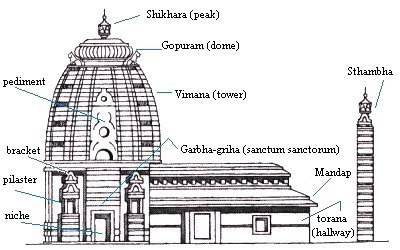
Dravidian Style (South Indian Temple Architecture)
- Geographical Spread: Predominantly in Southern India, especially Tamil Nadu.
- Key Features:
- Vimana: The pyramidal tower over the garbhagriha, which is smaller in comparison to the gopuram (gateway).
- Gopuram: Large, ornate entrance gateways that are often taller than the vimana.
- Enclosed Compound: Temples are enclosed within walls, with the outer wall integrating the gopurams.
- Pillared Halls: Known as mandapas, used for various purposes, including dance and music performances.
- Water Tank: Commonly found inside the complex for ritualistic purposes.
- Key Features:
- Examples: The Brihadeeswarar Temple at Thanjavur, the Meenakshi Temple at Madurai.
Vesara Style (Deccan or Mixed Style)
- Evolved in Deccan India, blending elements of both Nagara and Dravidian styles.
- Geographical Spread: Mainly in Karnataka, during the Chalukya and Hoysala periods.
- Key Features:
- Synthesis of Styles: Merges the Nagara and Dravidian styles, often seen in star-shaped platforms.
- Decorative Elements: Richly decorated with sculptures and friezes depicting epics and puranas.
- Lathe-turned Pillars: A unique feature where pillars are intricately carved, resembling lathe work.
- Ceiling Art: The ceilings often display elaborate carvings, adding to the ornamental richness.
- Key Features:
- Examples: The Chennakesava Temple at Belur, the Hoysaleswara Temple at Halebidu.
Various Famous Vesara Style Temples under different rules
The south Indian temple architecture was dominated by Chalukyan, Hoysala, Rashtakuta, and Vijayanagara.
Architecture by them are discussed in detail below:-
Chalukyan Architecture
- Early Chalukyan emperors were responsible for the beginning of the Vesara architecture style’s history.
- Their architecture was a combination of Nagara and Dravida styles. Not a single temple was represented wholly in Dravida or Nagara style.
- Initially, they developed their temple as a version of the Dravidian or octagonal style. After some time, they evolved it into a unique style, mainly because of the star-shaped plan and projecting angles in circles with centers in the middle of the shrine and mandapa.
- Aihole, Badmi, and Pattadakal all have temples that served as the focal point of Chalukyan civilization. The Chalukya Dynasty kings built many temples, which served as the best example of hybrid Vesara architecture.
- Some of the famous temples built by them are Papanath Temple (680 CE), Virupaksha Temple (740 CE), Lad Khan Temple, and others.
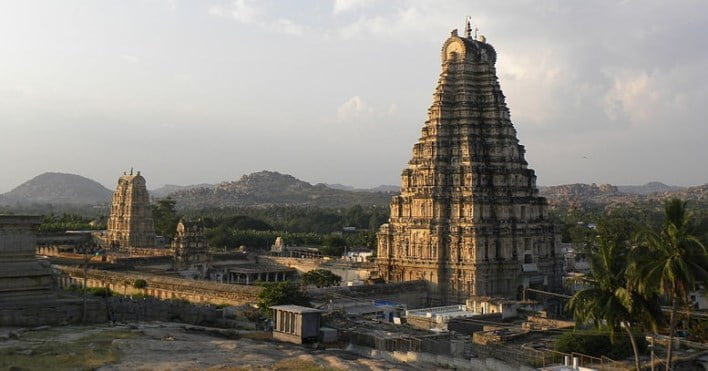
Rashtrakuta Architecture
- Rashtrakuta Dynasty kings adopted Dravidian and Pallava styles, which can also be found in the Kailash temple at Ellora, Aurangabad. Buddhist, Jain, and Brahmanical rock-cut temples can also be found in Ellora.
- The majority of their temples were built in the Chalukyan style.
- In the 8th century, Rashtrakuta king Krishna I constructed the Kailashnath Temple at Ellora. That is a magnificent example of rock carving and architecture.
- They also built a Jain temple in Pattadakkal.
- Some of the famous temples built during their time period are Navalinga Temple, Kukkanur, Cave Temples, etc.

Hoysala Temple Architecture
- Under the Hoyasala dynasty, temple structures in the Vesara style achieved their pinnacle (1000 C.E.–1300 C.E.).
- Chalukyan-Hoyasala architects primarily employed greenish or bluish-black chlorotic schist to construct these temples.
- Key Features:
- Star-Shaped Platform: The platform or base of the temples is often star-shaped, which adds to the complexity and beauty of the design.
- Sculpture Work: The walls of these temples are covered with an endless variety of depictions from Hindu mythology, animals, birds, and dancing figures. The level of detail in the carvings is extraordinary.
- Ceilings and Pillars: The interior of the temples is equally intricate, with beautifully carved ceilings and lathe-turned pillars, each uniquely designed.
- Soapstone Material: Hoysala temples are built using soapstone, which has a smooth finish and allows for intricate carving.
- Example: Chennakeshava Temple at Belur, The Hoysaleswara Temple, Kesava temple in Somanathpura, etc.
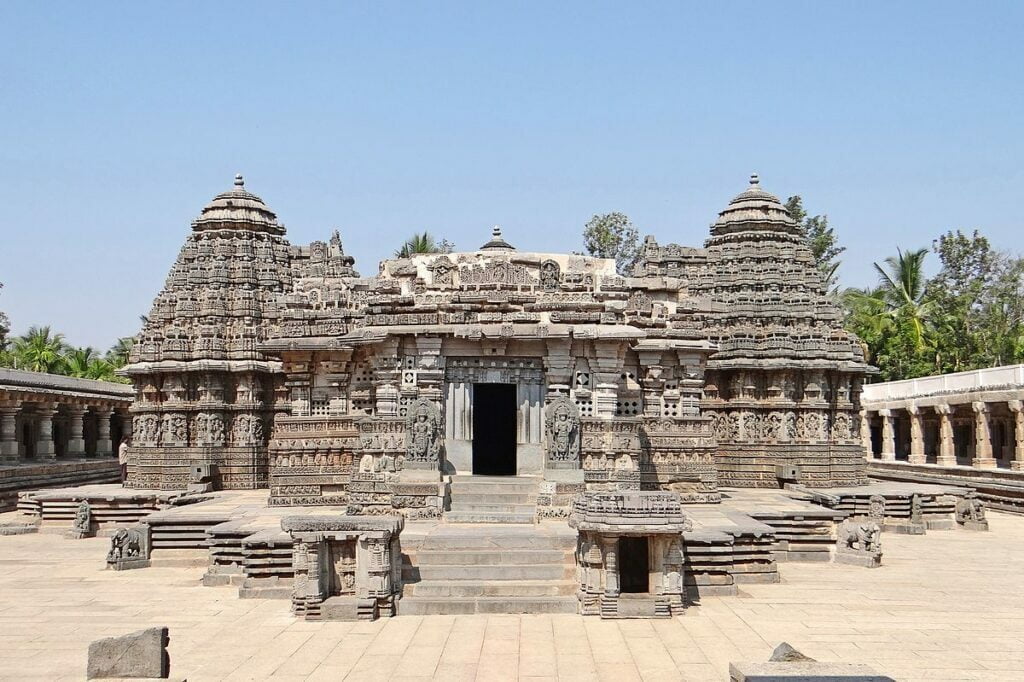
Vijayanagara Architecture
- They combined the architectural elements of the Chola, Hoysala, Pandya, and Chalukya empires.
- The architectural style began to be influenced by the Indo-Islamic style of Bijapur under them, as can be seen in the temples they built during their time period.
- The temples built by them were highly decorated with geometrical patterns and carvings.
- The surrounding walls were taller, and pillars had a mythical creature called Yali carved into them.
- Virupaksha Temple, Hampi, and the Hazara Rama Temple of Deva Raya 1 are the greatest examples of Vijayanagar style that represent them in a better way.
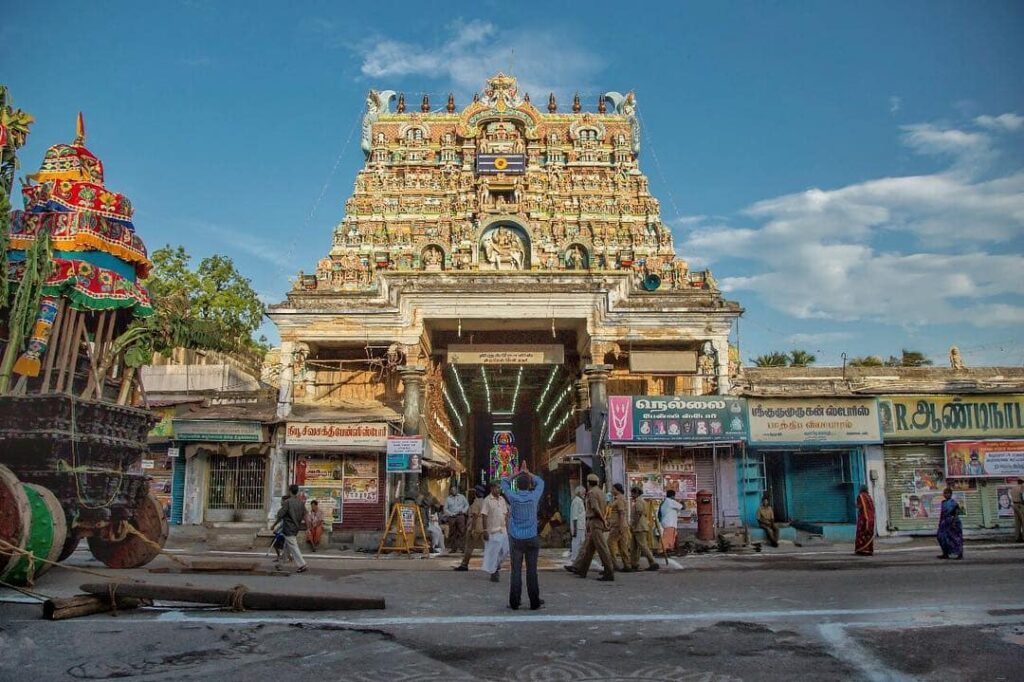
We can't clear UPSC for you.
But with our personalised mentor support, you'll be ready to do it yourself.
Kalinga Style (Orissan Temple Architecture)
- Originated in Odisha and known for its vertical division.
- Three main parts: Deula (sanctum), Jagamohana (assembly hall), and Natamandira (festival hall).
- Rekha Deula: This is the style used for the sanctum sanctorum, characterized by a tall, curvilinear shikhara (temple tower). The Lingaraja Temple in Bhubaneswar is a notable example.
- Pidha Deula: Used for the assembly hall (jagamohana), these structures have a pyramidal roof made up of horizontal platforms, resembling a stepped pyramid.
- Khakhara Deula: This style is specific to shrines dedicated to female deities and has a barrel-like roof. The Vaital Deula temple is an example.
- These styles are distinguished by their ornate decoration and the emphasis on vertical growth in their structures.
- Examples: Jagannath Temple in Puri, Lingaraja Temple in Bhubaneswar.
Maru-Gurjara Style (Rajasthani Temple Architecture)
- Indigenous to Rajasthan and Gujarat.
- Key Features:
- Ornamentation: This style is known for its intricate carvings, both on the exterior and interior. The ornamentation is often so dense that the base stone is barely visible.
- Mandapa Feature: It often includes a mandapa or hall, which is a significant feature of the temple, used for various rituals and ceremonies.
- Ceiling Designs: The ceilings are usually elaborate, with multiple layers of carvings depicting deities, dancers, musicians, and geometric patterns.
- Jain Influence: The Dilwara Temples near Mount Abu, a Jain pilgrimage site, are the most exemplary of this style, with extraordinary marble carvings.
- Bhumija Towers: Some temples of this style feature unique towers called Bhumija, which are decorated with miniature spire motifs.
- Examples: Dilwara Temples at Mount Abu, Sun Temple at Modhera.
Hemadpanthi Style
- This style of architecture was named after Hemadpant, a minister in the court of the Yadavas of Devagiri in the late 13th century.
- Material Used: The hallmark of Hemadpanthi architecture is the use of locally sourced black stone and lime, making the structures robust and weather-resistant.
- Design Features: Buildings in this style are known for their simplicity and lack of elaborate ornamentation.
- The structures are functional yet elegant, with a focus on durability and utility.
- Temple Architecture: In temples, the Hemadpanthi style often features a star-shaped plan, similar to the Hoysala style, but simpler in ornamentation. The shikhara (temple tower) is usually pyramidal.
- Examples: Amruteshwar Temple in Ratanwadi, Maharashtra.

Mamluk Style (Indo-Islamic Architecture)
- The Mamluk style marks the beginning of Muslim architecture in India, starting in the 13th century with the establishment of the Delhi Sultanate.
- Architectural Features
- The style is characterized by the use of arches, domes, and minarets.
- The Mamluk buildings were the first to use the true arch and dome construction method in India.
- Material and Ornamentation: The style often employs red sandstone with marble decorations. Calligraphy and geometric patterns are common, with minimal figurative art due to Islamic aniconism.
- Mosque Architecture: Mamluk mosques typically include a large prayer hall, a courtyard, and tall minarets.
- Examples: The Qutub Minar and the Alai Darwaza at the Qutub complex in Delhi are prime examples.
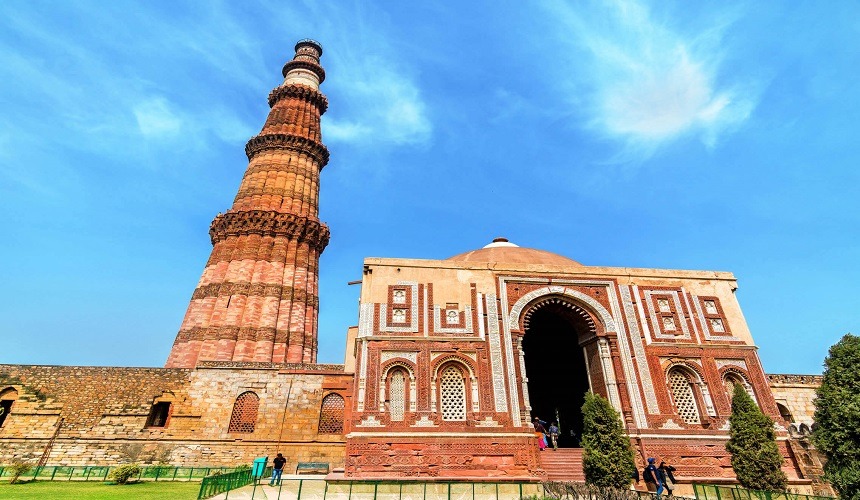
Kadamba Style
- Origins and Development: The Kadamba style originated with the Kadamba Dynasty, which rose to power in the 4th-6th centuries in the region that is now Karnataka.
- It is considered one of the earliest indigenous styles to evolve in Southern India.
- Architectural Features: Kadamba architecture is known for its simplicity and shikhara (temple tower) designs, which were prototypes for later Dravidian temples.
- The shikharas are pyramid-shaped and consist of stepped tiers that culminate in a cupola.
- Material and Construction: The use of locally available material, including brick and mortar, was prominent.
- The temples often feature a square sanctum (garbhagriha) and a porch.
- Decorative Elements: Although simpler compared to later Dravidian temples, some Kadamba structures exhibit intricate carvings and sculptures.
- Examples: Madhukeshwara Temple in Banavasi.
Himalayan Style Architecture
- Geographical Influence: Predominant in Himachal Pradesh, Uttarakhand, and nearby Himalayan regions, this style adapts to harsh climates with heavy snowfall.
- Key Features:
- Wooden Structures: Extensive use of wood for resilience, particularly against earthquakes. Wood is a primary material due to its availability and practicality.
- Sloping Roofs: Steep, gabled roofs, often with slates or wooden shingles, prevent snow accumulation and protect the structure.
- Pagoda Style Elements: Influenced by the Nepalese Pagoda style, many temples feature tiered roofs, blending aesthetics with functionality.
- Carvings and Motifs: Despite functionality focus, intricate carvings of local flora, fauna, and deities are common, showcasing skilled craftsmanship.
- Examples:
- Hidimba Devi Temple, Manali (Known for its pagoda-style roof and intricate wooden carvings)
- Baijnath Temple, Himachal Pradesh (A fusion of medieval North Indian architecture with Himalayan elements)
- Kedarnath Temple, Uttarakhand (Predominantly built of stone, incorporates Himalayan architectural elements suited to its high-altitude, snowy environment.)
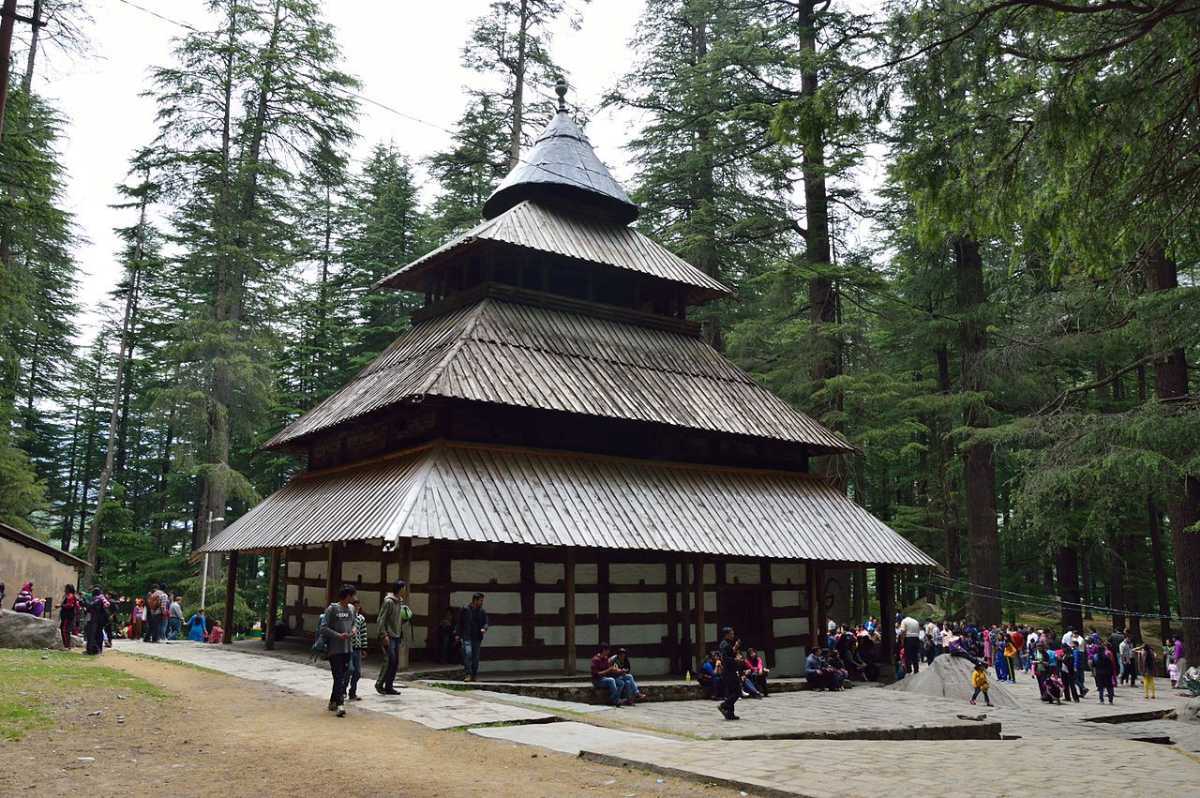
Hidimba Devi Temple, Baijnath Temple, Kedarnath Temple
These diverse temple styles not only reflect India's architectural genius but also its deep-rooted spirituality, cultural diversity, and artistic excellence.
Previous Post